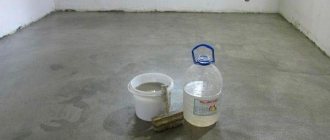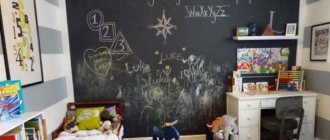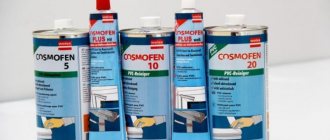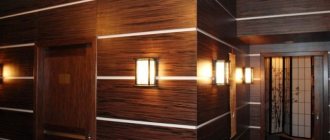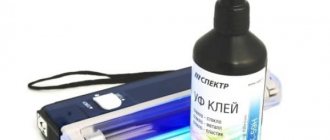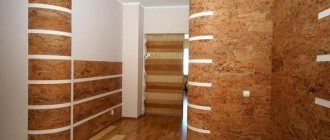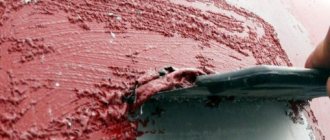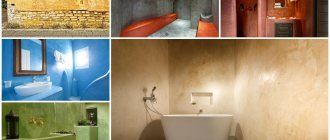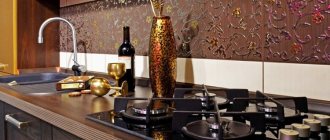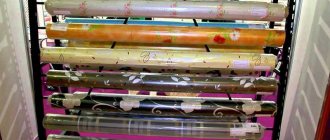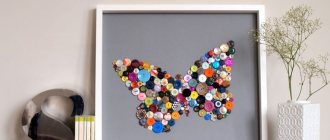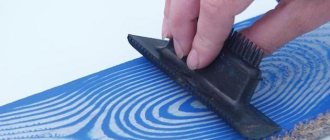And now you can proudly say: “These are my liquid glass products, made with my own hands!” And now you don’t have to master the difficult and generally harmful profession of glassblowing in order to make unique, fragile, fascinating decorations for your home, for yourself, as a gift for loved ones and friends, New Year’s decorations for the Christmas tree, etc. The passion for crafts made from liquid glass is gaining momentum and attracts more and more creative people with a subtle sense of style and beauty.
General description of the tablecloth
The kitchen and dining room in a house or apartment must be in perfect order.
This is due to the fact that food is prepared and eaten in these rooms. This places high demands on furniture and interior items located on them. To protect the tabletop, housewives use various tablecloths made from different materials or oilcloth. But as experience says, sometimes they can be ineffective. However, progress is constantly evolving and offering consumers new materials. Transparent or translucent glass tablecloths began to be used to protect the tabletop. They are practical, multifunctional, and can be used in any interior.
The use of such coatings will ensure complete protection of the countertops from mechanical damage, liquids, grease and oil. The presence of the film prevents them from being absorbed into the countertop.
Tablecloths are practical, multifunctional, and can be used in any interior.
Recommendations for caring for “soft glass”
A transparent tablecloth “soft glass” or “soft glass” does not require special care. It will be enough to wipe its surface with a soft sponge or a piece of lint-free cloth (it may stick to the film). In the fight against grease stains and traces of dyes, simple household chemicals for the kitchen, which are found in every home, will help.
It is convenient to store it folded or rolled - after unpacking, the film will return to its original form without additional effort.
Note! Do not use abrasive products (hard sponges and brushes, liquid gels with scratching granules) and undiluted alkalis and acids. They may damage the product.
The “soft glass” tablecloth appeared in the kitchen not so long ago, but quickly became an indispensable assistant in protecting surfaces from damage. It can also add a special accent to the interior and become an original and practical solution.
The characteristics of the material allow it to be used in various climatic conditions: air humidity and thermal effects will not damage the layer of protective film.
Sources:
https://berkem.ru/tekstil/zashhitnaya-skatert-dlya-stola-myagkoe-steklo/
Prices for tables made of wood and epoxy resin: from original works to factory models
Tables and tables filled with epoxy on one of the most famous websites of handicraftsmen cost from 20,000 rubles, as of October 2021. The price depends on the complexity of the work. There are many options with complex inlays and multi-component designs; you can buy such tables made of epoxy resin for a price of 50,000-150,000 rubles. As for factory models, for example, the price of tables from Estwood starts at 36,000 rubles. and reaches up to 140,000 rubles, depending on the size and purpose.
Save time: selected articles delivered to your inbox every week
latest comments
Imagine a kitchen or bathroom countertop made of wood. Naturally, wax or varnish is not the best option for finishing, and it simply doesn’t make sense to spend a lot of money on stone because
it is brittle, which is not unimportant, and scratches. I came up with the option described below and did it myself, periodically trying to find the most complete explanation on the Internet, but there was always something missing
This detail has nothing to do with the tabletop, which I started photographing from the moment the liquid glass was applied, but the process is identical. In this case, we make the tabletop from MDF veneered with oak veneer. We are preparing slats 1″ wide from any solid wood, which will not only be attached to the end part adding strength to the product, but will also be something like a decorative element. In this case, to get a more pronounced oak texture, I used a blowtorch to burn the veneer (I’ll immediately note that special fanaticism should be avoided, do not forget this is the veneer, do not burn it) then light sanding after which only the textured recesses will remain darkened. We go around the ends in an array and grind again.
This is a two-component liquid glass or epoxy: a solution and a catalyst. It is not at all necessary to use this particular set; any will do. The main thing is to read the instructions: proportions, drying time and shades.
Because
It is important to maintain the proportion; I recommend not mixing by eye. Use a scale
You need two of these: one for the solution (resin), the other for the hardener (catalist).
You should absolutely not use a mixer for stirring; I just used sticks.
Preparing the place: the surface must be ABSOLUTELY horizontal and leveled at 360°, otherwise the epoxy will flow to one side and you will not be able to correct the result. The part should lie on supports installed on this surface. Prepare the solution and pour it onto the part in a spiral from the center.
We disperse the solution with this simple spatula. The solution should flow from all sides (do not forget this is a countertop)
And here she is. leave for about 20 minutes in a warm place, do not touch. During the drying process, small air bubbles will appear inside the liquid glass - you can simply get rid of them using the same blowtorch that we used to burn out the oak texture.
I used this one, but any will do. The main thing is that it is convenient for you to hold it at a distance of about 6 - 7 inches from the part, heating problem areas with quick and confident movements
When warming up, you should pay attention to the fact that as the temperature rises, the fluidity of the solution increases, therefore you need to be careful on vertical surfaces
By the way, a spatula is not suitable for applying the solution on vertical surfaces. This foam brush did the job perfectly.
Sizes and shapes of the “flexible glass” tablecloth
Depending on the shape of the table, there are “soft glass” tablecloths.
- Round (standard size – 100, 115 cm).
- Oval (standard size - selected individually).
- Square (standard size – 50x50 cm).
- Rectangular (standard size – 50x100 cm – 100x250 cm with the possibility of modification).
READ How to Make a Handheld Circular Saw Table
The features of the material from which they are made allow them to be given almost any shape, even the most intricate and imaginative. The same applies to size. It can be easily adjusted to the desired number.
Compared to other types of decorative coverings, a transparent tablecloth Soft flexible glass has many advantages.
There is a main rule that will help you choose the right size of tablecloth (if it is silicone). It states that this decorative element must exceed the area of the tabletop by no less than 20 percent. This applies to everyday tablecloths, but if we talk about festive ones, then 70-80 percent is acceptable here. Depending on the individual preferences of the home owners, these indicators may vary.
The material meets international and domestic safety and quality standards - hypoallergenic, non-toxic, non-flammable.
A “flexible glass” tablecloth (both PVC and silicone) can be made strictly according to the size of the table, without going beyond its boundaries. It can also be laid on a textile covering, then the pattern or design on it will look more voluminous and impressive.
Tablecloth Soft glass requires basic care: it is enough to wipe it with a damp microfiber cloth or any other soft textile.
From sheet stone
It would seem that making something from sheet plastic or, as it is called, artificial stone is not a problem. That's how it is. Parts of the desired shape and size are cut from the sheet, and they are glued together. The seams are polished, removing at the same time possible differences in height.
Lots of polish. But this is for any artificial stone
The assembled structure is either glued onto a solid base (with a stone thickness of up to 10 mm), or a frame is made of wood or plywood. Everything seems to be easy. Except that:
- A sheet of material weighs a lot, and moving it is a pleasure.
- The cuts must be perfect, as well as the fit of the parts. This requires professional equipment and the ability to use it.
- The joints are glued and fixed with clamps. They are placed approximately every 20-30 cm. Even for gradual, leisurely work, the number of clamps is about ten.
- To sand joints you need a good sander. You can get by with grinding discs on a grinder. But the tool must be able to adjust the speed.
In order to pull the parts of the tabletop as tightly as possible, temporary stops are placed. Clamps are attached to these stops
And so yes. You can make a countertop from sheet artificial stone with your own hands. To have an idea of how and what we are talking about, watch the video. There are practically no explanations, but the technology of the work can be traced. But for better connection of parts (when gluing edges), it is better to choose a quarter in the main sheet. This way the seam will not be so noticeable, and the connection will be more reliable.
Which tabletops are suitable for a “soft glass” tablecloth?
This tablecloth is a real find. It is perfect for countertops made of various materials.
For a glass table, soft glass will provide additional protection.
Protects against cracks, scratches and chips. Thanks to its transparency, the “soft glass” tablecloth will be almost invisible on the glass.
A kitchen table made of natural wood or metal will be protected from particles of fat, juice, hot broth or products with coloring properties.
Particles of products and household chemicals will not destroy or stain the surface. Such a film will extend the “life” of the tabletop many times over.
The product can also be combined with a plastic tabletop. This combination is most often used in children's rooms.
Dyes and fat will not eat into the pores. The tabletop will also be protected from scratches and cuts.
Thanks to the shock-absorbing properties of polyvinyl chloride, it will soften impacts and prevent moisture from entering the structure of the stone, thereby extending its service life.
READ How to Choose a Circular Disc
Will soften impacts and prevent mechanical and chemical damage to the surface. Silicone and PVC are heat-resistant, so this coating will be an excellent protection for a stone countertop.
Advantages and disadvantages
Like any other material, artificial stone has pros and cons. Before choosing a stone countertop, carefully study all the positive and negative aspects.
Many are alarmed by the fact that they will have to tinker with the formation of a casting from artificial stone. It is much easier to order a wooden board and cut a tabletop from it. But if you put in a little more effort, the result will exceed all expectations.
The main advantages of countertops made of cast and liquid stone:
- Hygienic and environmentally friendly. The absence of microrelief makes it easy to remove moisture and dirt. Bacteria and microbes simply do not have time to accumulate on the surface, which eliminates the occurrence of fungus.
- Easy to care for. The countertop does not require special cleaning technology. Just wipe it with a damp cloth and traces of cooking are gone.
- Resistant to damage. The surface is not afraid of water, household chemicals, boiling water and even a knife. You can cut food on the countertop without using a board.
- Durability. Thanks to its high strength, even an object falling from the shelf will not leave a mark on the surface. The material has all the properties of real polished granite, so it is not afraid of serious damage.
- Maintainability. You can correct a misunderstanding in the form of a small scratch in no time. It is enough to sand the damaged area. If a chip is found, it can be filled with a new layer of liquid stone. After restoration, the tabletop regains its original appearance.
The material also has disadvantages:
Although the tabletop is durable, it may not withstand a blow from a heavy object.
Handle a hatchet and meat hammer with care.
Overcharge. Artificial stone is more affordable than natural stone, but more expensive than other materials.
If you handle and care for the countertop with care, then all costs will be justified. The performance characteristics of the material are at the highest level - such a table will serve for decades without losing its attractive appearance.
Protective tablecloth for table “soft glass”
The kitchen is a place where various processes related to cooking and caring for dishes and other utensils are carried out every day. This explains the fact that this particular room, like no other, needs frequent and thorough cleaning. Frequent use of detergents and abrasive materials can deteriorate the appearance of kitchen furniture over time. This is especially true for work surfaces and the dining table.
Soft glass is a table made from polyvinyl chloride.
Prices for tables made of wood and epoxy resin: from original works to factory models
Tables and tables filled with epoxy on one of the most famous websites of handicraftsmen cost from 20,000 rubles, as of October 2021. The price depends on the complexity of the work. There are many options with complex inlays and multi-component designs; you can buy such tables made of epoxy resin for a price of 50,000-150,000 rubles. As for factory models, for example, the price of tables from Estwood starts at 36,000 rubles. and reaches up to 140,000 rubles, depending on the size and purpose.
Save time: selected articles delivered to your inbox every week
latest comments
Imagine a kitchen or bathroom countertop made of wood. Naturally, wax or varnish is not the best option for finishing, and it simply doesn’t make sense to spend a lot of money on stone because
it is brittle, which is not unimportant, and scratches. I came up with the option described below and did it myself, periodically trying to find the most complete explanation on the Internet, but there was always something missing
This detail has nothing to do with the tabletop, which I started photographing from the moment the liquid glass was applied, but the process is identical. In this case, we make the tabletop from MDF veneered with oak veneer. We are preparing slats 1″ wide from any solid wood, which will subsequently not only be attached to the end part, adding strength to the product, but will also serve as something of a decorative element. In this case, in order to get a more pronounced oak texture, I used a blowtorch to burn the veneer (I should immediately note that special fanaticism should be avoided, do not forget this is veneer, do not burn it), then light sanding, after which only the textured recesses will remain darkened. We go around the ends in an array and grind again.
This is a two-component liquid glass or epoxy: a solution and a catalyst. It is not at all necessary to use this particular set; any will do. The main thing is to read the instructions: proportions, drying time and shades.
Because
It is important to maintain the proportion; I recommend not mixing by eye. Use a scale
You need two of these: one for the solution (resin), the other for the hardener (catalist).
You should absolutely not use a mixer for stirring; I just used sticks.
Preparing the place: the surface must be ABSOLUTELY horizontal and leveled at 360°, otherwise the epoxy will flow to one side and you will not be able to correct the result. The part should lie on stands installed on this surface. Prepare the solution and pour it onto the part in a spiral from the center.
We disperse the solution with this simple spatula. The solution should flow from all sides (do not forget this is a countertop)
And here she is. leave for about 20 minutes in a warm place, do not touch. During the drying process, small air bubbles will appear inside the liquid glass - you can simply get rid of them using the same blowtorch that we used to burn out the oak texture.
I used this one, but any will do. The main thing is that it is convenient for you to hold it at a distance of about 6 - 7 inches from the part, heating problem areas with quick and confident movements
When warming up, you should pay attention to the fact that as the temperature rises, the fluidity of the solution increases, therefore you need to be careful on vertical surfaces
By the way, a spatula is not suitable for applying the solution on vertical surfaces. This foam brush did the job perfectly.
Silicone table pads
Types of soft glass tablecloths:
- The bulk of silicone pads are available in a colorless version.
- There are silicone tablecloths for tables with a pattern, which allows you to give the room a more original look. Any design is applied to the film on the inside, which guarantees a long service life. Most often, images of fruits, berries, flowers and intricate geometric shapes are used.
Transparent silicone pad with a pattern
Buyers have the opportunity to purchase a matte film; it looks quite unusual on the countertop and does not interfere with the overall interior.
Matte silicone pad us tol Ikea
For the convenience of using thick film, you can attach special corner silicone pads to the corners of the table. They additionally prevent premature damage to furniture.
Corner silicone table pad
Advantages of “soft glass” film for the table
Goes well with textiles, stone, wood and other materials. Transparent texture can make the texture of the tabletop more voluminous and multi-layered.
It is universal and easily fits into any interior style.
This kitchen tablecloth will prevent premature wear of the furniture. It protects the table from the effects of almost any destroyers: cuts and punctures with a knife, dents, absorption of cosmetics by the tabletop, fat, both vegetable and animal, alcohol, fillers for felt-tip pens and paints. “Soft glass” is not afraid of high temperatures, alkali and acid (if they are not concentrated).
The coating combines harmoniously with textiles, natural wood or stone.
Thanks to this feature, this tablecloth is suitable for any kitchen.
Performance characteristics allow you to install Soft glass on any table .
Soft glass film is durable and wear-resistant. It can last for many years without losing its appearance.
READ How the Makita df457d screwdriver gearbox works
It will protect the surface from wear caused by external factors.
The material from which such tablecloths are made is non-toxic, does not cause allergies and is not flammable.
Despite the high degree of transparency, it is thick enough to protect the tabletop from accidental cuts with a knife or office utensils.
The thickness of the soft protective glass layer is 2mm, which is quite sufficient for domestic needs.
Alternative options
The tabletop can be covered with a “liquid” tablecloth or soft oilcloth. This is a transparent or multi-colored polyvinyl chloride film.
It tolerates moisture, dirt and mechanical stress well. The advantage is a tight fit and ease of application. All you need to do is clean the table, wipe it dry and put on a PVC cover.
Care Tips
Craftsmen do not recommend soaking or washing the coating earlier than a week after it hardens. At the same time, there is no special care. The frozen surface can be wiped with a damp or dry cloth.
If greasy stains are found, they are wiped off with soapy substances. The material does not get along well with abrasives, so contact with them is also undesirable.
How to properly lay and trim a tablecloth on a glass table
As a rule, “soft glass” film is packaged in the form of a roll. This does not affect its shape and texture in any way. However, you should not use a knife when unpacking.
To prevent mechanical damage to the material, it is wrapped in a layer of cardboard or craft paper.
There are no difficulties in laying it, but if we are talking about a glass surface, then for a quick and good result it is better to follow a special algorithm.
- Place the film on a horizontal surface to allow it to shrink and straighten after unpacking.
- Adjust it to the size of the table (if necessary).
- Prepare the countertop: remove dust, moisture, dirt and stains.
- Place the film with the wrong side on the table .
- Press it, moving from the center to the edges.
- If any air bubbles remain, spray the film with water and repeat the steps.
It does not require additional fastening: despite the low price, Soft glass on the table is easy to use.
If the shape or size of a transparent glass tablecloth does not match the table, then it can be trimmed.
Soft glass should be spread on a cutting board, and the cut location should be marked with a marker or pen. Using a utility knife, cut out a piece of the desired shape and size.
The silicone film can be left hanging from the countertop. She will look very colorful.
It is prohibited to use abrasives (dry powders), gels interspersed with hard granules, undiluted alkaline and acidic compounds to clean the tablecloth film.
But it is better to adjust the PVC tablecloth to the size of the table surface (2-3 mm smaller than the main surface). How to do this?
- Make the necessary markings with a marker.
- Place on a cutting board.
- Cut off any excess using a utility knife.
It is important that the edges of the transparent tablecloth made of PVC film Soft glass do not protrude beyond the table, otherwise the covering can accidentally get caught.
Requirements
It should be noted right away that you won’t be able to save on material. Those resin modifications that are low cost are unlikely to be suitable for creativity, since they do not meet the requirements presented below. Among the technical parameters, the minimum layer thickness is of practical importance. No craftsman needs instant hardening of the resin. After pouring, the compound should have time to fill all the cavities, and air bubbles should come to the surface.
In addition, if there is decor, you may need to make some adjustments to its placement. If you take resin in a volume less than recommended, it will begin to set very quickly, which will negatively affect the quality of the product. As a rule, the first layer of resin is used to fix the decor at the base of the tabletop.
Many beginners prefer to choose brands of resins that allow them to fill the countertop in one go, but there is a certain nuance here.
- Firstly, layer-by-layer filling allows you to create three-dimensional images when decorating each layer.
- Secondly, the large volume of resin that has to be poured at one time can cause intense heat generation during curing.
Useful to know > What is epoxy glue and where is it used?
If the master decides to opt for a resin with a maximum layer thickness of 5-6 cm, then preference should be given to those models that have a long lifetime, because it guarantees a low reaction rate of the interaction of the components.
Typically, final curing takes about a day. However, you need to read the instructions to clarify this parameter. The fact is that the next layer can be poured only after the previous layer has completely cured. The remaining selection criteria are related to the cost and popularity of the manufacturer. If the cost is very easy to determine, then the rating of manufacturers and suppliers will have to be studied additionally. It is useful to take advantage of the advice and tips of experienced craftsmen. We will give several examples of popular brands that, in all their parameters, meet the requirements for filling countertops.
How to cover a wooden countertop in the kitchen
The ideal option for protecting a wooden tabletop is a bio-impregnation based on natural vegetable oils and beeswax - that is, oil-wax for wood. Natural oils for wood can make its surface waterproof, which means that the wood is not afraid of fungus and mold. By the way, a countertop impregnated with high-quality oil and wax becomes resistant to standard kitchen detergents—nothing bad will happen to wood from diluted household chemicals. It is even better and more reliable to treat the kitchen work surface with a special oil for wood that comes into contact with food. And of course, no one has canceled the more familiar coatings - interior varnish for wood or a combination of colored azure with subsequent application of varnish.
How to apply liquid glass to the table: technology
To cover the tabletop with liquid glass, we recommend using the manufacturer’s instructions. It describes step-by-step actions that will guide you in the principles of operation.
Prepare the necessary equipment. It is better to keep it at hand so as not to be distracted.
Tools
To work you need to stock up on the following equipment:
- bucket for construction work;
- a drill with an auger-style attachment that will stir the thick solution;
- brush;
- cement mixture;
- sifted fine sand;
- pure water;
- spatula made of metal or plastic.
To ensure the job is done efficiently, do some preliminary preparation. The master needs to create a full-fledged glass coating effect. To do this, first ventilate the room, then eliminate dust and drafts.
Treatment
Before applying the diluted mixture, the wood must be leveled and cleaned. First, the surface is treated with an antiseptic primer, then puttied to fill all the cracks.
Next, the wood is sanded to remove knots and level its surface. It is better to do this with a grinding machine. You can also use coarse sandpaper, but then the work will take much longer.
When sanding is complete, the wood is coated with a finishing penetrating primer. To apply it evenly, we recommend using a roller.
Application
The table is covered with liquid glass in several layers. There should be at least two, but the more, the better. The second and subsequent balls can be applied only after the previous ones have completely hardened.
Principles of material application:
- The composition must be diluted with clean running water in the ratio specified by the manufacturer.
- Apply it evenly using rollers or brushes of different sizes.
- The material is placed in two or more layers.
- During this process, small air bubbles will appear on the surface. They are removed by heating with a blowtorch. Do this more carefully with vertical surfaces, because when heated, the material becomes more fluid.
- The solution must be poured from the central part to the edges using spiral movements. If necessary, the master can level the coating with a spatula.
- If work is carried out with horizontal coverings, it is better to level the work area. Or there is a possibility of uneven distribution of the mixture.
- Application must be quick as it hardens quickly. The master has no more than twenty minutes for all actions.
Final stage
The final stage is drying the product. This takes approximately one day. The time depends on the material used and its manufacturer.
It hardens completely at room temperature. Avoid vibrations and other mechanical influences to avoid defects in the coating.
Liquid glass: composition and scope of application
Liquid glass is, in fact, a modern silicate glue, available at any hardware store. It contains water-based sodium or potassium silicate. The invention of 1818 was credited to Jan von Fuchs. This scientist mixed alkali and silicon acid and obtained a substance that resembles liquid glass in its physical properties. Subsequently, many researchers and inventors turned to the question of how to make liquid glass. For example, there is a known variant of alloying ordinary river sand and soda, carried out at very high temperatures.
Silicate glue in the form of a ready-made mixture is diluted with water in the proportions specified in the instructions. The resulting thick solution is used for its intended purpose for gluing. Possessing strong adhesive characteristics, it penetrates deeply into the upper layers of the surfaces to be bonded. It can handle almost any material, from paper, wood, rubber, to ceramics and glass.
It is used as protection for a variety of materials due to its antiseptic properties. For example, it is used for external processing of objects made of plaster and wood. Serves as a reliable barrier against moisture, dust, mold. Homemade plaster sculptures coated with liquid glass can be placed in a garden or park without fear of damage from the external environment.
IMPORTANT!
Guarantee of success: preparation
To mix the material you will need a bowl (the volume depends on how much epoxy you need), a mixing stick and two measuring containers. Before mixing, you need to carefully study the instructions: the proportions of the components are different and depend on the manufacturer. They must be strictly observed, otherwise the material will not harden well.
First, the epoxy is measured, and then the resin hardener. You need to pour it into the base, and not vice versa. The combined materials are kneaded as thoroughly as possible; the quality of hardening also depends on this. Once homogeneity is achieved, you need to wait until the resin reaches the desired consistency, after which you can use it for its intended purpose.
Production process
Before applying a new coat, wait for the previous one to dry completely.
In construction and renovation, this material is often used for glazing openings and covering various decorative elements on the walls of a house. Recently, decorating furniture, interiors, clothing, making jewelry, etc. has also become increasingly popular.
For example, a tabletop made by yourself at home looks very unusual and stylish. You need to make a wooden base and legs for it, then cover it with silicate glue. A properly made table will acquire mirror smoothness and shine. Some craftsmen on the Internet suggest laying identical coins over the entire area of the tabletops, and then filling them with liquid glass.
You can also use silicate glue to decorate photo frames, jewelry boxes, watches, mirrors, etc. Use pieces of broken glass, sparkles, beads, shells, and dried plant parts as glued decorative elements. In general, give free rein to your imagination and creative inspiration!
Requirements
It should be noted right away that you won’t be able to save on material. Those resin modifications that are low cost are unlikely to be suitable for creativity, since they do not meet the requirements presented below. Among the technical parameters, the minimum layer thickness is of practical importance. No craftsman needs instant hardening of the resin. After pouring, the compound should have time to fill all the cavities, and air bubbles should come to the surface.
In addition, if there is decor, you may need to make some adjustments to its placement. If you take resin in a volume less than recommended, it will begin to set very quickly, which will negatively affect the quality of the product. As a rule, the first layer of resin is used to fix the decor at the base of the tabletop.
Many beginners prefer to choose brands of resins that allow them to fill the countertop in one go, but there is a certain nuance here.
- Firstly, layer-by-layer filling allows you to create three-dimensional images when decorating each layer.
- Secondly, the large volume of resin that has to be poured at one time can cause intense heat generation during curing.
If the master decides to opt for a resin with a maximum layer thickness of 5-6 cm, then preference should be given to those models that have a long lifetime, because it guarantees a low reaction rate of the interaction of the components.
Typically, final curing takes about a day. However, you need to read the instructions to clarify this parameter. The fact is that the next layer can be poured only after the previous layer has completely cured. The remaining selection criteria are related to the cost and popularity of the manufacturer. If the cost is very easy to determine, then the rating of manufacturers and suppliers will have to be studied additionally. It is useful to take advantage of the advice and tips of experienced craftsmen. We will give several examples of popular brands that, in all their parameters, meet the requirements for filling countertops.
Polymer selection
The resin must be transparent, and this transparency must be stable over time. Today, the production of furniture from epoxy is not a novelty, so you should look for resin for countertops in the store. The following parameters serve as a guideline:
- minimum permissible layer thickness;
- maximum permissible layer thickness;
- lifetime;
- complete drying time.
Let us briefly point out the significance of these parameters. The minimum thickness of the master layer, as such, is not of interest. Even if the elements are pre-treated with a thin layer of resin, there are no criteria here. But this parameter indicates fluidity. The thinner the layer, the more liquid the composition will be. This is an important parameter, since the liquid resin must penetrate into all cavities and form a horizontal surface.
The maximum permissible layer thickness determines the number of layers for making a countertop. This allows you to correctly calculate the volume of epoxy for waste-free production. For beginners with no experience, it is recommended to buy brands that allow you to fill the countertop with epoxy resin in one go. Although it is easier to avoid bubbles and deal with them if they appear when pouring layer by layer. The maximum thickness is 5-6 cm. But when pouring layer-by-layer, more possibilities open up. Decorative elements placed in different layers create the effect of a 3D image.
The life time of the composition is of interest to some craftsmen in the sense that it is the time during which the resin remains fluid. It is necessary to pour the epoxy in time so that it spreads evenly over the mold. In fact, even without skills it’s not difficult to get it done in the shortest possible time. The shorter the pot life, the more active the hardener is. The chemical reaction between the components of the resin proceeds with the release of heat. The active hardener will cause the resin to boil and cause bubbles to form. It is necessary to choose formulations with a long shelf life.
Liquid glass on the table: selection criteria
Take this seriously. Not every liquid polymer glass is suitable for a tabletop. Therefore, we recommend that you look through reviews from previous customers. They will talk about the characteristics of a particular composition and how it manifests itself in work.
We advise you to buy products only from well-known brands. Storage conditions and method of transportation are also important. If they are not observed, the composition will not cope with its functions, and its quality will be reduced to zero.
Famous brands
The most popular brands in Russia that produce liquid glass for the table:
- “KUBANZHELDORMASH”. A mechanical engineering company founded about eighty years ago. We established the production of epoxy resin.
- “ALECTICH.” Epoxy is manufactured and produced. Their products are used by many furniture factories.
- “TRADE HOUSE GLASS PRODUCT”. A Sochi company that has received a lot of positive feedback from customers.
- "METTERRA". They only have the sodium type mixture in their catalogue.
- "SILICATE". Their product line is especially common on the market.
If the material is in transparent packaging, we recommend choosing a jar without sediment, flakes, clumping or foreign impurities. The market is replete with factory goods. And this is good, because then you can be confident in the quality of the product.
But there are also goods in packaging without labeling. We advise you not to purchase such liquid glass. After all, there is a high probability that this is a fake.
How to choose liquid glass
A tabletop made of liquid glass will look and have the necessary properties if only the silicate adhesive is selected correctly. Initially, it is worth reading customer reviews of individual products, from which you can understand how this or that product performs.
It is better to choose products from well-known manufacturers; you should pay attention to the storage method and conditions of transportation of the material. If they are violated, the quality of the resulting product will be reduced. Among the most popular manufacturers of silicate glue are: Kubanzheldormash, Alektich, Trading House Stekloprodukt, Mettera, Silikat. All these are domestic brands.
It is preferable to leave the choice on transparent packaging, through it it will be visible whether there are sediments, various impurities, or clumping in the product. It is better to choose the option without them.
Finding a factory product is not difficult, because there are many of them on sale. It is better to choose these products; if there is no marking on the packaging, then it is probably a fake, the quality of which is unlikely to be good.
It is preferable to leave the choice on transparent packaging, through it it will be visible whether there are sediments, various impurities, or clumping in the product.
